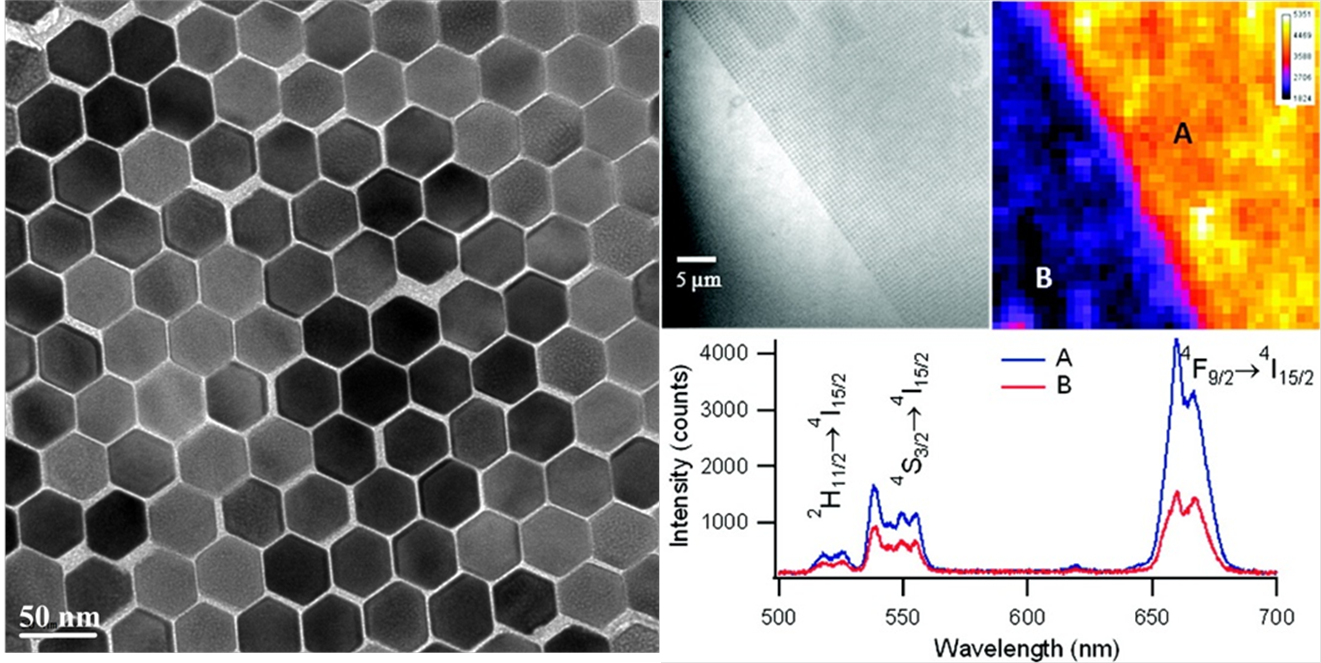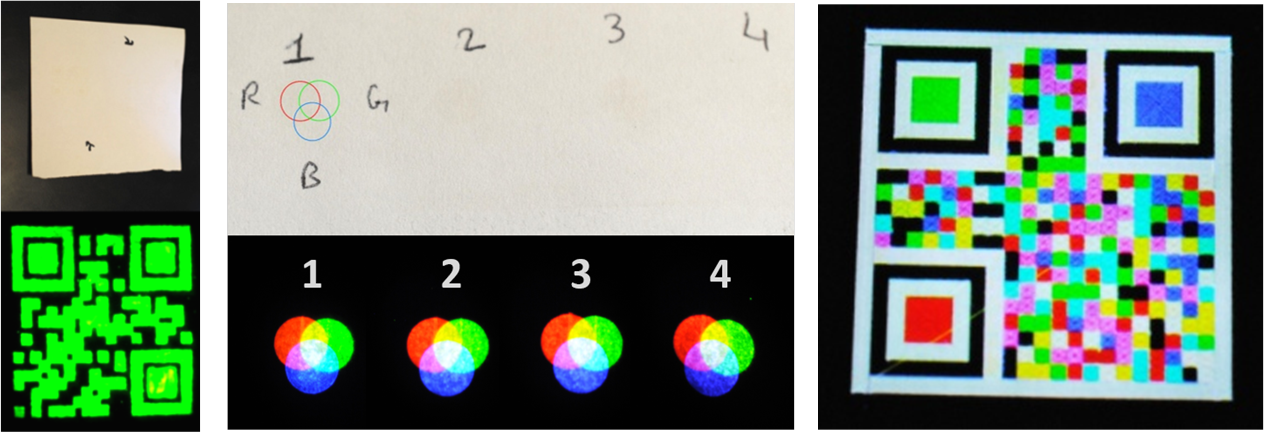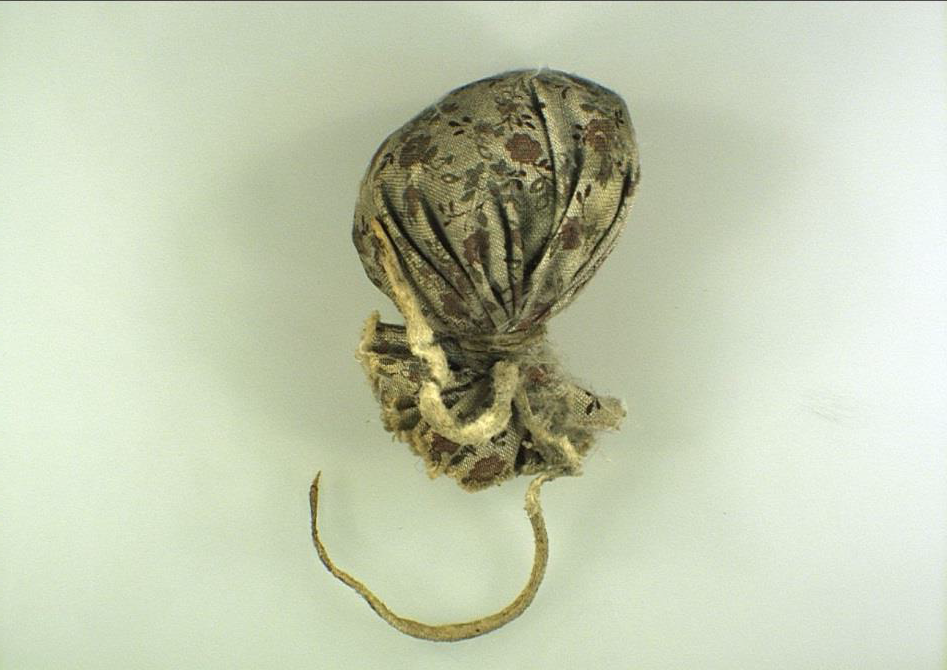SPACT Center Research Roadmap
The researchers within the Center for Security Printing and Anti-Counterfeiting Technology (SPACT) believe that the next generation of security-end products will result from the intersection between disciplines. The diagram below shows a high-level overview of a roadmap developed to guide SPACT research toward the generation of next-generation security-end products.
The image below displays some of the initial SPACT research products, all of which were developed by an interdisciplinary team of researchers.
Examples of SPACT research are shown below in the form of ‘Research Nuggets’ below:
SPACT Research Nugget #1: Covert Printing using Upconverting Nanoparticle Inks
SPACT researchers have pioneered the printing of covert (in the visible) upconverting nanoparticle (UCNP) security inks. The UCNPs are synthesized by the P. Stanley May research group at USD. The image below shows a monolayer of the UNCPs and their response on a gold plasmonic surface. Emission is enhanced by plasmonic array of gold nanopillars and the emission on and off nanopillar array.
The SPACT research team has formulated the UCNPs into a variety of inks for use on industrial printing platforms. An example of the security print image produced by the SPACT team is shown below.
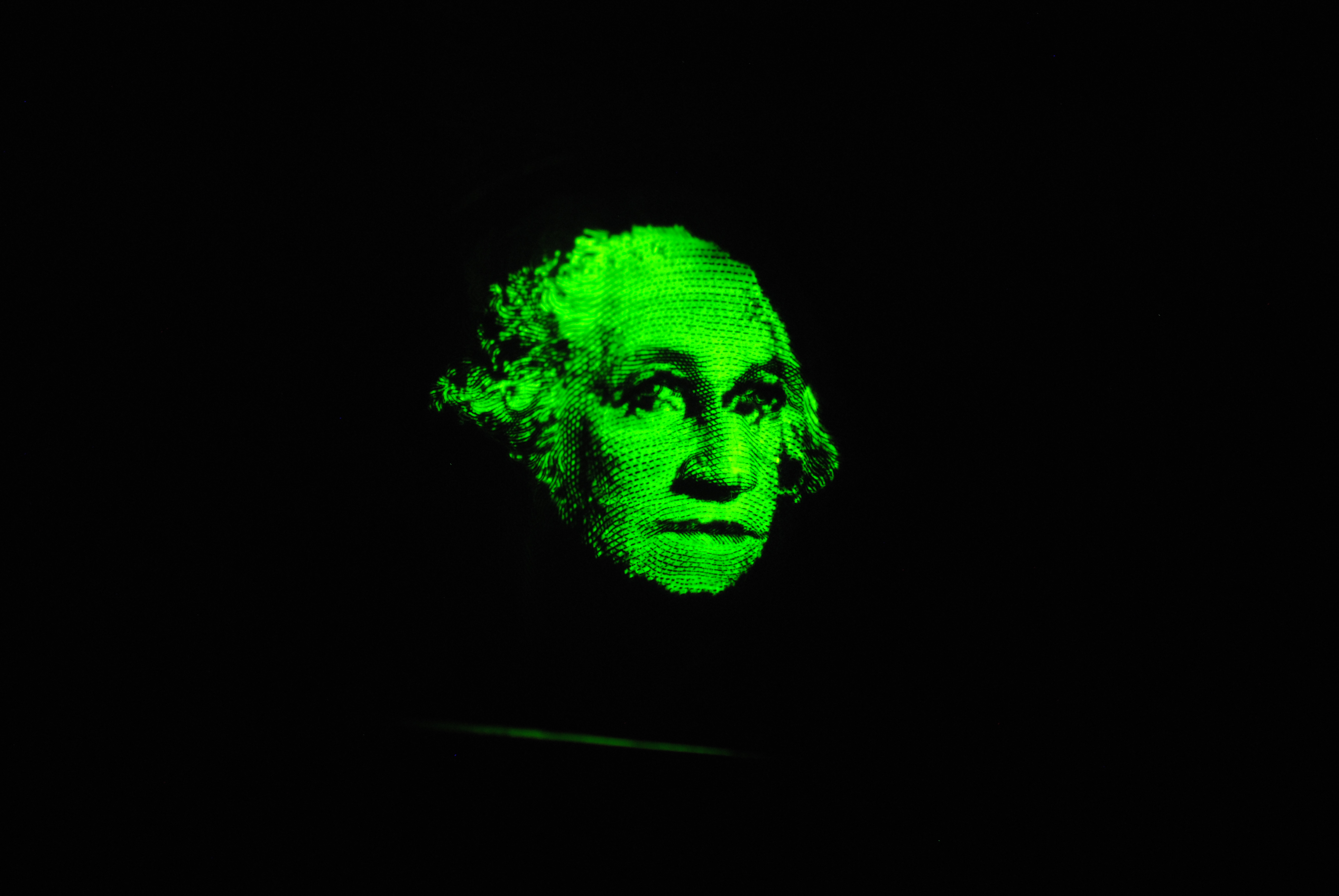
The above research was detailed in the following SPACT publications and patent:
- Blumenthal, T., Meruga, J., May, P.S., Kellar, J., Cross, W., Luu, Q.N., “Patterned Direct –Write and Screen Printing of NIR-to-Visible Upconverting Inks for Security Applications,” Nanotechnology, 23 (2012) 185305 (8pp), (journal cover feature)
- Luu, Q.; Hor, A.; Fisher, J.; Anderson, R. B.; Liu, S.; Luk, T. S.; Paudel, H. P.; Baroughi, M. F.; May, P. S.; Smith, S.: Two-Color Surface Plasmon Polariton Enhanced Upconversion in NaYF4:Yb:Tm Nanoparticles on Au Nanopillar Arrays. J Phys Chem C 2014, 118, 3251-3257.
- Paudel, H. P.; Zhong, L.; Bayat, K.; Baroughi, M. F.; Smith, S.; Lin, C.; Jiang, C.; Berry, M. T.; May, P. S.: Enhancement of Near-Infrared-to-Visible Upconversion Luminescence Using Engineered Plasmonic Gold Surfaces. J. Phys. Chem. C 2011, 115, 19028-19036.
- Systems and Methods for Printing Patterns using Near Infrared Upconverting Inks, US 20140261031 A1, Jon Kellar, Stanley May, William Cross, Jeevan Meruga, Tyler Blumenthal, patent filed 3/14/14.
SPACT Research Nugget #2: Using Covert Quick Response Codes for Security Applications
Quick response (QR) codes are 2D codes that are routinely used for identification purposes, not the least of which is for product identification. SPACT researchers have used covert QR codes for authentication and security purposes. Shown in the figure below are QR codes printed using the UCNP-based inks described in Nugget #1. The figure (middle) also demonstrates the use of R-G-B color theory using colored UCNPs. The image on the right used color layering to increase the data payload capacity by 3x.
The above research was detailed in the following SPACT publications:
- Meruga, J.M., Baride, A., Cross, W., May, P.S. and Kellar, J.J. “Red-Green-Blue Printing using Luminescence-Upconversion Inks,” Journal of Materials Chemistry C., 2014, 2, 2221-2227.
- Meruga, J.M., (Nesson) Fountain, C., Kellar, J.J., Crawford, G., Baride, A., May, P.S., Cross, W. and Hoover, R., “Multi-Layered Covert QR Codes for Increased Capacity and Security,” International Journal of Computers and Applications, in press.
As shown below SPACT researchers have also utilized covert QR codes for marking of pharmaceutics. In this case the ink was a non-toxic luminescent material. The printed QR code was covert under ambient lighting, as shown in Figure 2a, but luminesced green when excited with long‑wavelength UV light (right image). The luminescent QR code was readable with a Smartphone QR reader app.
The above research was detailed in the following SPACT publication:
- Meruga, J., Kern, J., Petersen, J., Logue, B., Baride, A., May, P.S., Cross, W., Crawford, G., Tamayo, D., Richards and Kellar, J., “Innovative Security Applications using Direct-Write Printing,” Keesing Journal of Documents and Identity, to appear issue 47, 6/15/15.
SPACT Research Nugget #3: Development of Optically Variable Inks
SPACT researchers have developed inks that print optically variable (OV) features. In this example the ink composition is 1 wt% of silver nanoparticles (NPs) and poly(methyl methacrylate) (PMMA) in 90:10 v/v toluene/methyl benzoate solution. The silver NPs printed on the substrate undergo a spontaneous phase‑separation from the PMMA during solvent evaporation. A scanning electron microscope image of the printed features clearly shows the phase separation.

Macroscopically the optical variance is seen upon tilting and the corresponding angular-dependent transmission spectra parallels the absorption and reflection in the 400 to 550 nm regime. The figure below demonstrates the OV and spectral response. The OV silver ink patterns can be used on critical documents, such as passports, identity cards and credit cards.
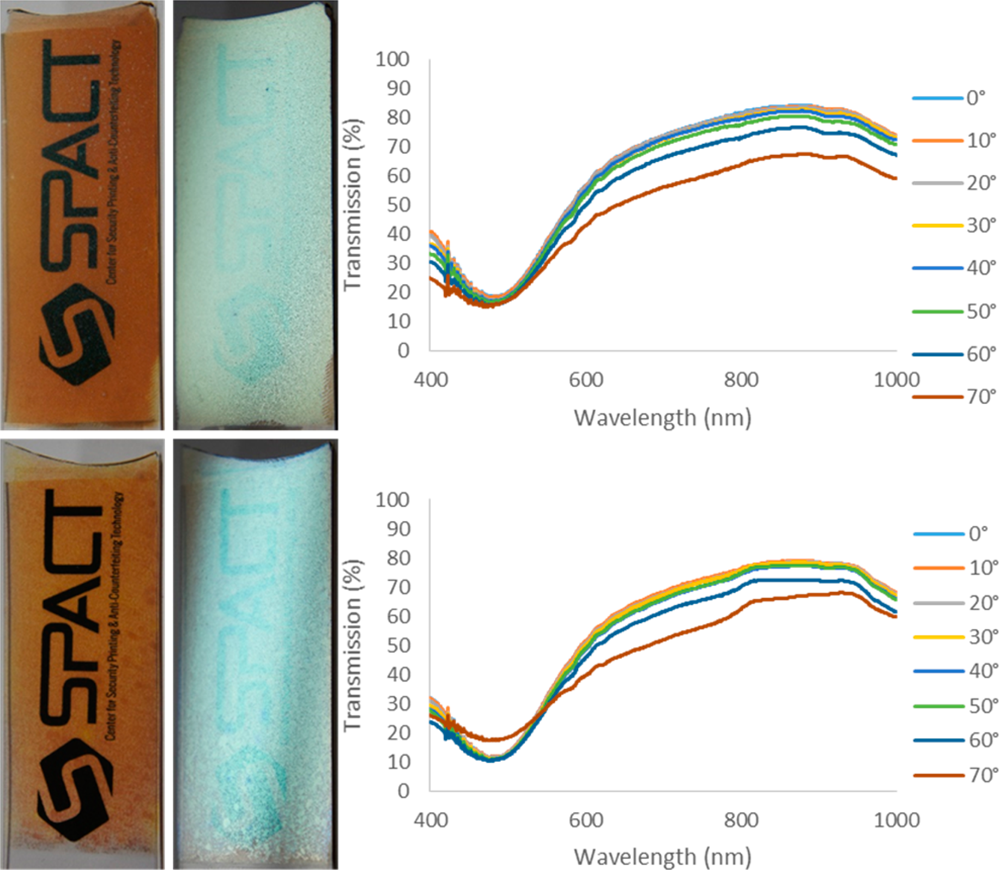
The above research was detailed in the following SPACT publication:
- Petersen, J., Meruga, J., Randle, J., Cross, W. and Kellar, J., “Hansen Solubility Parameters of Surfactant- Capped Silver Nanoparticles for Ink and Printing Technologies,” Langmuir, 2014, 51, 15514-9.
SPACT Research Nugget #4: Optically Scannable Code Antenna
SPACT researchers have developed printed electronic devices that can be used as multifunctional, overt security-end products (SEPs). An example of this concept is this concept is shown in the figure below. The SEP consists of a readable QR code that also acts as an antenna that can be read remotely. The QR code/antenna was designed to operate at 1.9 GHz and could be used to track and trace products.
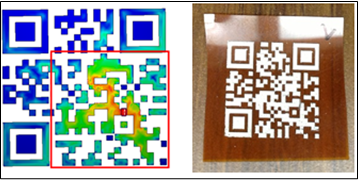
The above research was detailed in the following SPACT publication and patent:
- Numan-Al-Mobin, A.M, Meruga, J.M., Cross, W.M., Kellar, J.J. and Anagnostou, D.E., “QR Code Antenna for Wireless and Security Applications”, Proceedings IEEE Antennas and Propagation International Symposium AP-S / USNC-URSI 2013, pgs 1728-1729.
- Optically Scannable Code Antenna, US 20140263662 A1, Dimitrios Anagnostou, William Cross, Jeevan Meruga, Jon Kellar, patent filed 3/14/14.
SPACT Research Nugget #5: Cultural Heritage Science–Authentication of Lakota Artifacts
SPACT researchers have partnered with the Heritage Center at Red Cloud Indian School to conduct forensic analysis of select pieces of their collection for authentication analysis. One of the pieces analyzed was a pouch from a bustle. The pouch was identified as non-ceremonial in nature though thought to be 100+ years old. Micro-computed tomography (micro-CT) was used for non-destructive and non-invasive analysis of the inner contents of the pouch. Micro-CT revealed the presence of two metallic rings and organic material within the pouch. X-ray fluorescence revealed the rings to be copper. Shown below is an image of the pouch (less than 2″ in length) and the micro-CT reconstruction video (bottom).
The above SPACT research was detailed in the news report in the Washington Times:


